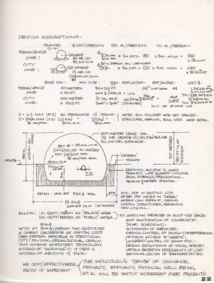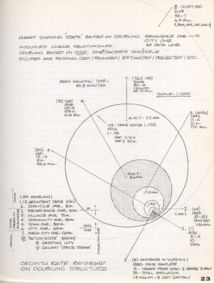“Don’t
Leave Home without it” |
|
Living
on one Planet is to engage the whole Human Race
in a single
point of failure “strategy.” This is stupid. End of argument.
|
|
Everything
else is a subordinate idea.
|
|
Responding
to this oversight can be a lot of fun. Going into
space will generate more wealth and discovery than
we have accomplished in our entire history to date.
|
|
It
takes about five minutes of thinking to understand
why space. But is does take thinking.
|
| It also takes digging a bit into the true history of the space effort starting with it’s modern origins in the 1920s. |
| Moving
into Space is not a government thing - it is a people
thing. Once we understand that, the process can
begin in earnest. Everyone and every institution
(including government) will have a role in it. |
|
Thinking
that “it’s all over” with this Planet
in terms of geological changes, meteor impacts and
possible human stupidity, is totally unsupported
by geology, anthropology and history - not
to mention common sense. There are estimated to
be 100,000 uncharted bodies in the asteroid belt
that are large enough to destroy all life on Planet
Earth. We do not know their orbits. On March 15,
2002 New Scientist reported:
|
“One
of the largest asteroids known to have approached
the Earth zipped past about 450,000 kilometres
away on March 8 - but nobody recorded it until
four days later.
“The
object, now called 2002
EM7, was hard to spot because it was moving
outward from the innermost point of its orbit,
87 million km from the Sun.
When
it passed closest to the Earth - just 1.5
times the distance to the
Moon - it was too close to the Sun to be visible.” |
We should be remembering the Dinosaurs not the Alamo.
The real question is how do we do it - how do we
go into space by a process we can afford with an
outcome oriented toward life?
|
| Getting hit by some object from near or deep space is but one of numerous disaster scenarios many of which are clearly embedded in the “myths,” and in some cases the clearly documented experiences of humanity. |
|
Space
can be achieved in a series of steps, each one,
useful and profitable in itself.
|
 |
| By designing, building and using a series of environments for communities - each progressively an order of magnitude larger in size and complexity - it is possible to do good in the moment and at the same time to learn-by-doing what it takes to build viable communities and societies on Earth, in space, and on other planets. |
|
| In
my mid 1975 (Notebook page 22) I outlined such
an approach. My reasoning then, and today, is that
a series of progressively larger and self contained
Mega-Structures would provide superior Earth-based
habitats and the practical knowledge-base necessary
for building and living in space. This is a pay-as-you-go
strategy. |
| This
approach would not solve the issues related to rockets
and space logistics, however, I considered them
(and still do) to be the easier-to-solve problems.
This is not underestimating the considerable technical
problems involved nor the genius involved in solving
them. Engineering will get us there in time - sooner,
if there is an economic environment that supports
incremental, profitable development. |
| A
controversial project, BioSphere
2 [link: bioshere 2], has been built and tested. This is not
what I had in mind, however, I suspect there is
real value in the experiment. I do not understand
the controversy that is involved with this venture.
It seems to me that everybody not involved in the
project is criticizing it from the vantage point
of what they would do if they had invested the time,
imagination and dollars to do it. Why not take it
on it on it’s own terms and learn - even support
rather than deter? Radical concept. If you have
a better idea offer it, join up or go make you own
project happen. |
progressive_doubling_environments |
| The critical issue with the making of human habitat is requisite variety. An environment for 30 people is not just twice as complex as on for 15 and 60 not just as complex again. Most human organizations grew organically - they emerged. In recent time we have tried to “design” them usually with mixed consequences. The failure has been to impose a too simple linear design process on a too complex problem. |
| The Taylor Method brings design intent to systemic, complex issues without distorting true emergence and thus generating unintended consequences. It does this by multiple iterations of design with a ValueWeb which represents all the players in the system-in-focus [link: valueweb architecture]. |
 |
It was projects like outlined in these Notebook pages which lead me the development of the Taylor System and Method.
Standard approaches to architecture, community development, city design, and the space program, do not have the inherent ability to address and resolve the complexities systemic to this kind of development. |
|
| My
approach suggested (Notebook page 23) building a
series of real living/working environments,
starting at the MLU [link: minimum living unit] and Domicile [link: domicile project] levels, and progressively evolving them along several
dimensions: the sophistication of the structures,
autonomous systems, size, community cultures, internal
economies and architectural values. |
| At the time, there seemed to be a market for this approach. Two things happened that shifted attention elsewhere. First, the demise of the space program. Second, the emergence of the growth 80s, and then the manic 90s when humanity seemed to convince itself that all natural constraints had somehow vanished. Slowly, near the end of the first decade of the 21st Century, some sanity has returned unfortunately imbued with too much depression. |
| In
time, these land-based structures would get
progressively lighter and more self-contained, and
could be matched up with launch, rocket and
space-systems technologies. Then, in-orbit habitats
could be built (only, however, if both efforts were designed from the beginning to do this). This integrated process is a
way to accomplish something like O’Neals Space
Colonies while having solved a number of social and
biological problems in advance. |
| In
1977, I was interviewed by Norie Huddle then representing
the L-5 Society. In it, I was critical of the social
and biological assumptions of O’neal’s
work because I believed these aspects were under
rated in both their importance and complexity. I
presented the L-5 society with a different model
of space development and a different set of underlying
Design Assumptions about it. The interview was never
published. I have put it on this website [link: taylor huddle space colony interview]. |
| Optimism was high in the 70s about humans in space. It is re turing now after 30 years of neglect. What turned us away and why is our focus slowing turning back now? |
|
|
| I
have never believed space to be a hostile environment
- to me, it is just the opposite. Keep the air in,
avoid space debris and watch radiation and you have
a stable, safe environment to develop in. One that
is full of resources by the way. Earth, by
contrast as wonderful as it is, is a high variety,
and on the human scale, an unstable environment.
Earth is the dangerous place to live! A great
place to visit. |
|
In
addition, much of human development - at least at
our present crude level of building - has an extraordinary
negative impact on Gaia beyond modest levels of
density and scope. Earth is a wonderful place for a small population to live and many to come to and enjoy. Lets turn the paradigm around: live
and develop in space, vacation and recreate on planets.
Earth is our mother and nest - comes a time, in
order to grow, you have to move out of your home
and go build a new life.
|
|
Many
of us, of course, will choose the Earth-style of
living and that is fine as long as this is done
with a steward’s mentality. The important thing
is that we humans understand that now this
is a choice. In a short time, it will become
an economic, biological, ecological necessity.
Given a disaster it will mean survival. Next time
you talk to a dinosaur - ask him, or her.
|
August 30, 2007 update:
A new theory postulates that there was an ice age impact in North America which decimated the majority of the large species on the continent [link: ice age blast ravaged america]. And, a prize offered for a remote sensing spacecraft for tracking space rocks [link: uk plan to track asteroid threat].
Are we learning? |
July 26, 2009 update:
A new article [link: space travel: the path to human immortality?] written by Tad Daily supports the thesis of this page simply and clearly. This and other pieces indicate that the single point of failure premise may be gaining in social equity.
This is improvement yet there remains three troubling issues. First, not a great deal is actually happening yet. This is not an agenda high on Humanity’s list. Second, as important and compelling this argument is - and one which I have been making since 1974 - it shows that we, as a species, remain both careless and reactive - two traits which are dangerous in combination. We simply do not pay attention to what threatens us and then overreact when disaster strikes. Third, as I point out over and over in my A Future by Design, Not Default piece, at best a generation passes before an idea becomes accepted and another before it is responded to and the solution ubiquitous; and, Humanity is not paying much attention to the Human Enterprise.
The defensive reasons are well made here. The positive reasons far out weigh them. These are hardly in the public debate such as it is. I strongly suspect our future is among the stars not fighting over who controls this one planetary piece of real estate. What shut down the quest into space? Why did we go to the Moon, then stop for a generation? There were arguments about the cost. Well, look at the wealth generated and squandered in the last 40 years and the wars fought with no conclusion. As I have said: if Humanity can afford to act as we are, we can afford anything.
We may be learning, but far too slowly.
|
|
click on icons below to go to relevant information |
|
| GoTo: A Future By Design - Not Default |
|
|
|
| GoTo: Katrina - An Unnatural Disaster |
|
|
|
| GoTo: Master Plan for Planet Earth |
|
|
|
| GoTo: Money - the Tool That Became... |
|
|
|
| GoTo: Planetary Architecture - The Case |
|
|
|
| GoTo: Space Colonies - L5 Interview |
|
|
|
| GoTo: THERE to HERE - every day |
|
|
|
| GoTo: UpSideDown Economics |
|
|
|
| GoTo: ValueWeb Architecture |
|
|
|
| GoTo: Zone of Emergence Model |
|
|
|
Matt
Taylor
Flying from Detroit to San Francisco
December 1, 1999
|

SolutionBox
voice of this document:
VISION • STRATEGY • SCHEMATIC
|
click on graphic for explanation of SolutionBox |
posted
December 1, 1999
revised
April 12, 2010
• 19991201.342316.mt • 20000118.110238.mt •
• 20000702.231546.mt • 20000727.235341.mt •
•
20020315.555510.mt • 20061130.231451.mt •
• 20090726.111000.mt • 20100412.878701.mt •
(note:
this document is about 75% finished)
Matt
Taylor 615 720 7390
me@matttaylor.com
Copyright©
Matt Taylor 1975, 1999, 2000, 2002, 2006, 2009, 2010
survey image Copyright© CNN, 2006
IP
Statement and Policy |
|
|